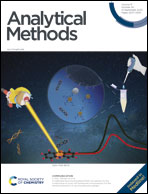An electrochemical microsensor based on a specific recognition element for the simultaneous detection of hydrogen peroxide and ascorbic acid in the live rat brain†
Abstract
A novel electrochemical microsensor was developed for the ratiometric and simultaneous determination of hydrogen peroxide (H2O2) and ascorbic acid (AA) based on the borate-phenol “switch” recognition mechanism and carbon nanotube (CNT) catalytic characteristics. First of all, a carbon fiber microelectrode (CFME) was coated with CNTs. Then, a specific probe, 9-anthraceneboronic acid pinacol ester (9-AP), was screened and decorated on CNTs through π–π stacking for the recognition of H2O2 based on the transformation of boric acid ester into electroactive phenols. CNTs not only served as the amplifiers of current signals, but also as catalysts facilitating AA oxidation. Meanwhile, ferrocenecarboxylic acid (Fc), inert to H2O2 and AA, was modified on another amino-functionalized CNT microelectrode via an amide bond as an internal reference channel for avoiding errors caused by environmental discrepancies. The two-channel ratiometric microsensor enabled the sensitive and accurate detection of H2O2 and AA simultaneously, and the detection limits were estimated to be 0.09 μM and 4.12 μM, respectively. The developed microsensor with remarkable analytical performance was finally applied for the simultaneous detection of H2O2 and AA in the live rat brain.



 Please wait while we load your content...
Please wait while we load your content...